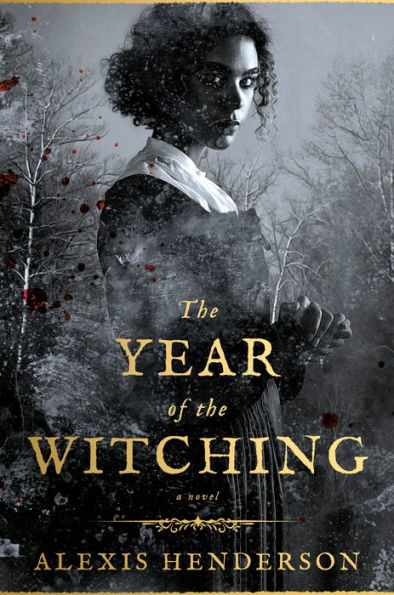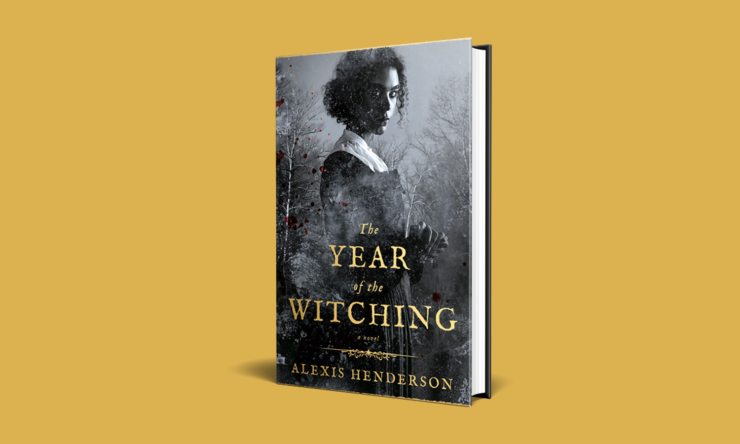The Year of the Witching is Alexis Henderson’s debut novel, but you’d never know it. It’s so well crafted and her point of view so well honed it feels like it should be her third or fourth book. The story is enchanting, enticing, enthralling, enigmatic.
Bethel is a land governed by a strict, fundamentalist religion. The Prophet rules the people and his Apostles enforce his will. The citizens in this rigid, harsh society worship a brutal god, one of fire and punishments and retribution. Anyone who acts against the will of the state or in defiance of tradition are declared witches and blasphemers and burned at the stake. Before she was even born, a dark skinned man from the Outskirts of Bethel, was executed by the Prophet. Her mother, young, pregnant, and desperate for vengeance, fled into the Darkwood and made a deal that cost her everything.
Seventeen years later Immanuelle, the daughter of the witch and the blasphemer, carries the burden of her parents’ sins. Rejected by most of the Bethelens and unable to live up to her family’s expectations, she feels lost. But a frightening incident in the Darkwood changes everything. A deadly curse takes hold and Bethel is wracked by plagues…and Immanuelle is the key to everything. With her dead mother’s secret journal guiding her and the Prophet’s handsome heir at her side, she will face the worst of humanity and battle the darkest magic.
Buy the Book


The Year of the Witching
For a dark fantasy like The Year of the Witching, setting is just as important as character and plot. Locations make manifest the existential horrors the characters experience. It’s a good thing, then, that Alexis Henderson is so damn good at it. The Darkwood haunts Immanuelle like a monster lurking in the shadows, and the scenes where she explores it are as creepy as any good horror story. Bethel, too, is just as vivid. Rotten with puritanical ideology and patriarchal prejudice, it unsettles as much as the Darkwood. Bethel’s religion is built on the belief in the Father, a god of fire and brimstone. His cathedral is an expanse of cold stone and sharp glass. In the Outskirts, they still worship the Mother, the goddess of witchcraft and the moon, and Henderson contrasts their church as one made of warm wood and earth. It’s impressive work that reels you in.
Much has been made of the story’s feminism, but little on its intersectionality. Immanuelle is not looked down on by her community solely because she is a woman or is genetically kin to the dark skinned people of the Outskirts; she is looked down upon because she is both. She exists at the intersection of dual oppressions, one based on gender the other on skin color. The social hierarchies forged by sexism and racism trap her at the bottom. Not even her relationships with the Prophet and his Heir can pull up her rank; white supremacy and the patriarchy made sure of that.
Yet because Immanuelle is also biracial and lighter skinned than her Outskirt relations, she also exists in a state of comparative privilege. She lacks privilege in all-white Bethel, but she suddenly has it when she enters the all-Black Outskirts. In Bethel she is the token Black person who must bear the weight of representing an entire people, especially when she does something the white people don’t like. To them, her father’s Blackness has corrupted her femininity as much as her mother’s rebellion. It is a strange place to be, even more so as a young person already struggling with trying to find her place in a hostile world. I am a light skinned biracial Black woman who has lived and worked in predominantly white spaces for most of my life. While Henderson left much of Immanuelle’s biracial experience as subtext, readers like me will pick up on the nuances.
Unfortunately, the book’s ending doesn’t quite live up to everything that precedes it. Henderson lets certain characters off the hook and doesn’t demand as much from others as she needed to. I wish she had pushed Immanuelle a little harder instead of falling back on debating the difference between doing what is right and what is just. The fizzle of the climax puts a dent in Henderson’s fiercely feminist message, but not one big enough to kill the thrill of the story.
Full of blood and bigotry, The Year of the Witching is a chilling twist on stories about religious extremism and occultism. What’s not to love in a book where dangerous witches, cruel men, and oppressive religious zealotry collide, and the outcast girl who must sacrifice everything to stop them? With a keen eye and a sharp tongue, Henderson breathes new life into an old trope. Alexis Henderson is a fresh new voice in dark fantasy, and I look forward to hearing more from her.
The Year of the Witching is available from Ace Books.
Read an excerpt here.
Alex Brown is a teen services librarian by day, local historian by night, author and writer by passion, and an ace/aro Black woman all the time. Keep up with her on Twitter and Insta, or follow along with her reading adventures on her blog.










